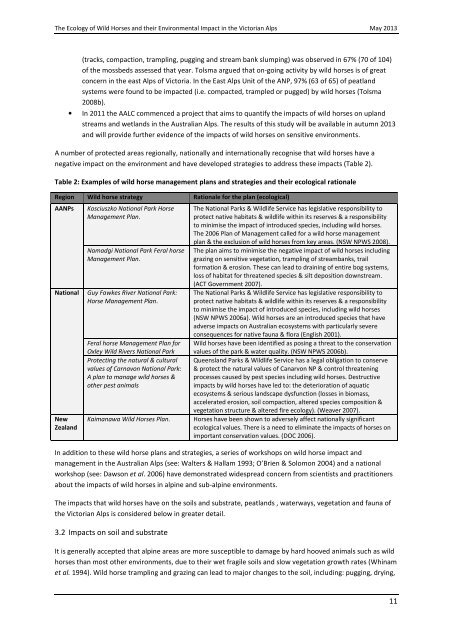The Ecology of Wild Horses and their Environmental ... - Parks Victoria
The Ecology of Wild Horses and their Environmental ... - Parks Victoria
The Ecology of Wild Horses and their Environmental ... - Parks Victoria
Create successful ePaper yourself
Turn your PDF publications into a flip-book with our unique Google optimized e-Paper software.
<strong>The</strong> <strong>Ecology</strong> <strong>of</strong> <strong>Wild</strong> <strong>Horses</strong> <strong>and</strong> <strong>their</strong> <strong>Environmental</strong> Impact in the <strong>Victoria</strong>n Alps May 2013(tracks, compaction, trampling, pugging <strong>and</strong> stream bank slumping) was observed in 67% (70 <strong>of</strong> 104)<strong>of</strong> the mossbeds assessed that year. Tolsma argued that on-going activity by wild horses is <strong>of</strong> greatconcern in the east Alps <strong>of</strong> <strong>Victoria</strong>. In the East Alps Unit <strong>of</strong> the ANP, 97% (63 <strong>of</strong> 65) <strong>of</strong> peatl<strong>and</strong>systems were found to be impacted (i.e. compacted, trampled or pugged) by wild horses (Tolsma2008b).• In 2011 the AALC commenced a project that aims to quantify the impacts <strong>of</strong> wild horses on upl<strong>and</strong>streams <strong>and</strong> wetl<strong>and</strong>s in the Australian Alps. <strong>The</strong> results <strong>of</strong> this study will be available in autumn 2013<strong>and</strong> will provide further evidence <strong>of</strong> the impacts <strong>of</strong> wild horses on sensitive environments.A number <strong>of</strong> protected areas regionally, nationally <strong>and</strong> internationally recognise that wild horses have anegative impact on the environment <strong>and</strong> have developed strategies to address these impacts (Table 2).Table 2: Examples <strong>of</strong> wild horse management plans <strong>and</strong> strategies <strong>and</strong> <strong>their</strong> ecological rationaleRegion <strong>Wild</strong> horse strategy Rationale for the plan (ecological)AANPsNationalNewZeal<strong>and</strong>Kosciuszko National Park HorseManagement Plan.Namadgi National Park Feral horseManagement Plan.Guy Fawkes River National Park:Horse Management Plan.Feral horse Management Plan forOxley <strong>Wild</strong> Rivers National ParkProtecting the natural & culturalvalues <strong>of</strong> Carnavon National Park:A plan to manage wild horses &other pest animalsKaimanawa <strong>Wild</strong> <strong>Horses</strong> Plan.<strong>The</strong> National <strong>Parks</strong> & <strong>Wild</strong>life Service has legislative responsibility toprotect native habitats & wildlife within its reserves & a responsibilityto minimise the impact <strong>of</strong> introduced species, including wild horses.<strong>The</strong> 2006 Plan <strong>of</strong> Management called for a wild horse managementplan & the exclusion <strong>of</strong> wild horses from key areas. (NSW NPWS 2008).<strong>The</strong> plan aims to minimise the negative impact <strong>of</strong> wild horses includinggrazing on sensitive vegetation, trampling <strong>of</strong> streambanks, trailformation & erosion. <strong>The</strong>se can lead to draining <strong>of</strong> entire bog systems,loss <strong>of</strong> habitat for threatened species & silt deposition downstream.(ACT Government 2007).<strong>The</strong> National <strong>Parks</strong> & <strong>Wild</strong>life Service has legislative responsibility toprotect native habitats & wildlife within its reserves & a responsibilityto minimise the impact <strong>of</strong> introduced species, including wild horses(NSW NPWS 2006a). <strong>Wild</strong> horses are an introduced species that haveadverse impacts on Australian ecosystems with particularly severeconsequences for native fauna & flora (English 2001).<strong>Wild</strong> horses have been identified as posing a threat to the conservationvalues <strong>of</strong> the park & water quality. (NSW NPWS 2006b).Queensl<strong>and</strong> <strong>Parks</strong> & <strong>Wild</strong>life Service has a legal obligation to conserve& protect the natural values <strong>of</strong> Canarvon NP & control threateningprocesses caused by pest species including wild horses. Destructiveimpacts by wild horses have led to: the deterioration <strong>of</strong> aquaticecosystems & serious l<strong>and</strong>scape dysfunction (losses in biomass,accelerated erosion, soil compaction, altered species composition &vegetation structure & altered fire ecology). (Weaver 2007).<strong>Horses</strong> have been shown to adversely affect nationally significantecological values. <strong>The</strong>re is a need to eliminate the impacts <strong>of</strong> horses onimportant conservation values. (DOC 2006).In addition to these wild horse plans <strong>and</strong> strategies, a series <strong>of</strong> workshops on wild horse impact <strong>and</strong>management in the Australian Alps (see: Walters & Hallam 1993; O’Brien & Solomon 2004) <strong>and</strong> a nationalworkshop (see: Dawson et al. 2006) have demonstrated widespread concern from scientists <strong>and</strong> practitionersabout the impacts <strong>of</strong> wild horses in alpine <strong>and</strong> sub-alpine environments.<strong>The</strong> impacts that wild horses have on the soils <strong>and</strong> substrate, peatl<strong>and</strong>s , waterways, vegetation <strong>and</strong> fauna <strong>of</strong>the <strong>Victoria</strong>n Alps is considered below in greater detail.3.2 Impacts on soil <strong>and</strong> substrateIt is generally accepted that alpine areas are more susceptible to damage by hard hooved animals such as wildhorses than most other environments, due to <strong>their</strong> wet fragile soils <strong>and</strong> slow vegetation growth rates (Whinamet al. 1994). <strong>Wild</strong> horse trampling <strong>and</strong> grazing can lead to major changes to the soil, including: pugging, drying,11
















